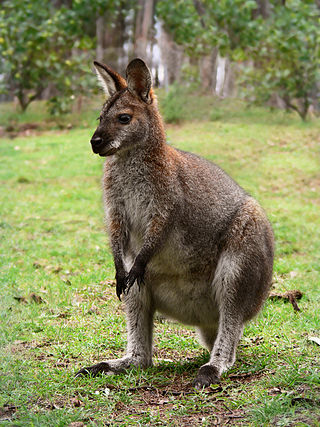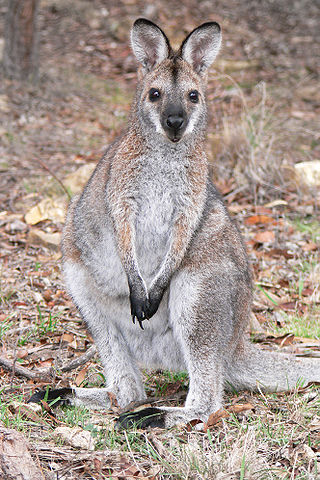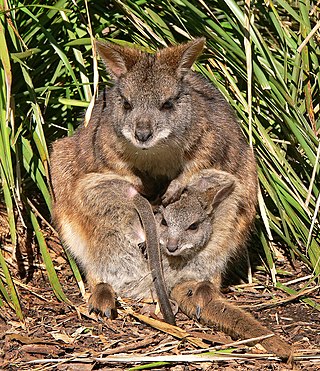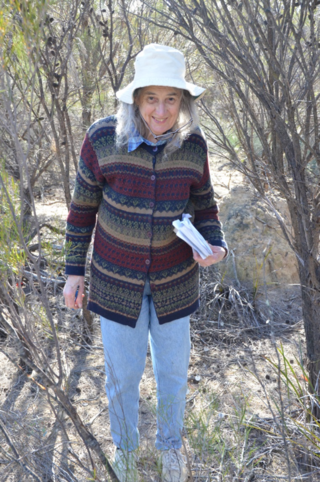Related Research Articles

Kangaroos are four marsupials from the family Macropodidae. In common use the term is used to describe the largest species from this family, the red kangaroo, as well as the antilopine kangaroo, eastern grey kangaroo, and western grey kangaroo. Kangaroos are indigenous to Australia and New Guinea. The Australian government estimates that 42.8 million kangaroos lived within the commercial harvest areas of Australia in 2019, down from 53.2 million in 2013.

Marsupials are any members of the mammalian infraclass Marsupialia. All extant marsupials are endemic to Australasia, Wallacea and the Americas. A distinctive characteristic common to most of these species is that the young are carried in a pouch. Living marsupials include opossums, Tasmanian devils, kangaroos, koalas, wombats, wallabies, and bandicoots among others, while many extinct species, such as the thylacine, are also known.

A wallaby is a small or middle-sized macropod native to Australia and New Guinea, with introduced populations in New Zealand, Hawaii, the United Kingdom and other countries. They belong to the same taxonomic family as kangaroos and sometimes the same genus, but kangaroos are specifically categorised into the four largest species of the family. The term "wallaby" is an informal designation generally used for any macropod that is smaller than a kangaroo or a wallaroo that has not been designated otherwise.

The honey possum or noolbenger, is a tiny species of marsupial that feeds on the nectar and pollen of a diverse range of flowering plants. Found only in southwest Australia, it is an important pollinator for such plants as Banksia attenuata, Banksia coccinea and Adenanthos cuneatus.

Macropodidae is a family of marsupials that includes kangaroos, wallabies, tree-kangaroos, wallaroos, pademelons, quokkas, and several other groups. These genera are allied to the suborder Macropodiformes, containing other macropods, and are native to the Australian continent, New Guinea and nearby islands.

The parma wallaby is a small, hopping, kangaroo-like mammal native to forests of southeastern Australia. About the size of a stout cat, it lives in dense shrub and is only active at night to feed on grasses and small plants. It is the smallest of the wallabies and carries its young in a pouch like other marsupials. Shy and elusive, it was believed extinct until rediscovery in the 1960s. It is threatened by habitat loss and is easily killed by non-native foxes.

The tammar wallaby, also known as the dama wallaby or darma wallaby, is a small macropod native to South and Western Australia. Though its geographical range has been severely reduced since European colonisation, the tammar wallaby remains common within its reduced range and is listed as "Least Concern" by the International Union for Conservation of Nature (IUCN). It has been introduced to New Zealand and reintroduced to some areas of Australia where it had been previously extirpated. Skull variations differentiate between tammar wallabies from Western Australia, Kangaroo Island, and mainland South Australia, making them distinct population groups.

Australidelphia is the superorder that contains roughly three-quarters of all marsupials, including all those native to Australasia and a single species — the monito del monte — from South America. All other American marsupials are members of the Ameridelphia. Analysis of retrotransposon insertion sites in the nuclear DNA of a variety of marsupials has shown that the South American monito del monte's lineage is the most basal of the superorder.

The pouch is a distinguishing feature of female marsupials, monotremes and possibly most extinct non-placental mammals including eutherians like Zalambdalestes ; the name marsupial is derived from the Latin marsupium, meaning "pouch". This is due to the occurrence of epipubic bones, a pair of bones projecting forward from the pelvis. Marsupials give birth to a live but relatively undeveloped fetus called a joey. When the joey is born it crawls from inside the mother to the pouch. The pouch is a fold of skin with a single opening that covers the teats. Inside the pouch, the blind offspring attaches itself to one of the mother’s teats and remains attached for as long as it takes to grow and develop to a juvenile stage.

Eugenia María del Pino Veintimilla is a developmental biologist at the Pontificia Universidad Catolica del Ecuador in Quito. She was the first Ecuadorian citizen to be elected to the United States National Academy of Sciences (2006). She was awarded the 2019 Prize of the Latin American Society for Developmental Biology for her strong contributions to research in Ecuador, and in general to promoting Developmental Biology in Latin America.

Most mammals are viviparous, giving birth to live young. However, the five species of monotreme, the platypuses and the echidnas, lay eggs. The monotremes have a sex determination system different from that of most other mammals. In particular, the sex chromosomes of a platypus are more like those of a chicken than those of a therian mammal.
Jennifer Ann Marshall Graves is an Australian geneticist. She is Distinguished Professor within the La Trobe Institute for Molecular Science, La Trobe University, Australia and Professor Emeritus of the Australian National University.
Rebecca Spindler is the head of science and conservation at non-profit conservation organisation Bush Heritage Australia. She previously was the manager of research and conservation at Taronga Conservation Society Australia, in the New South Wales Office of Environment and Heritage (OEH).
Janine Deakin is a professor at the University of Canberra and Executive Dean of the Faculty of Science and Technology. She is a geneticist with expertise in the areas of comparative genomics, epigenetics, genetic immunology and genome structure and regulation. A majority of her work has focused on the Australian marsupials and monotremes where her cytogenetic and molecular research on marsupial chromosomes and development of strategies to map genomes has provided important insight into the evolution of mammalian genomes.

Katherine Belov is an Australian geneticist, professor of comparative genomics in the School of Life and Environmental Sciences and Pro Vice Chancellor of Global Engagement at the University of Sydney. She is head of the Australasian Wildlife Genomics Group and research expert in the area of comparative genomics and immunogenetics, including Tasmanian devils and koalas, two iconic Australian species that are threatened by disease processes. Throughout her career, she has disproved the idea that marsupial immune system is primitive, characterized the South American gray short-tailed opossum's immune genes, participated in the Platypus Genome Project, led research identifying the properties of platypus venom, and identified the cause of the spread of the Tasmanian devil's contagious cancer.

Barbara Anne York Main was an Australian arachnologist and adjunct professor at the University of Western Australia. The author of four books and over 90 research papers, Main is recognised for her prolific work in establishing taxonomy for arachnids, personally describing 34 species and seven new genera. The BBC and ABC produced a film about her work, Lady of the Spiders, in 1981.
Patricia Woolley is Australian zoologist recognised for her work with marsupials, specifically the dasyurid family. Pseudantechinus woolleyae is named for her.
Robert John Aitken is a British reproductive biologist, widely known for identifying oxidative stress as a significant contribution to infertility and its actions on human sperm function. He also made substantial contributions to clinical practice translation in male reproductive health, notably the development of new contraceptive vaccine.
Thomas B. Hildebrandt is a German veterinarian researcher dedicated to species conservation. He heads the Department of Reproduction Management at the Leibniz Institute for Zoo and Wildlife Research (IZW) in Berlin and holds a full professorship for Wildlife Reproduction Medicine at the veterinary faculty of the Freie Universität Berlin.
References
- ↑ "Professor Marilyn Renfree". Faculty of Science. Science.unimelb.edu.au. Archived from the original on 14 August 2014. Retrieved 15 August 2014.
- 1 2 3 4 5 "Professor Marilyn Renfree". Australian Academy of Science. 7 April 2009. Archived from the original on 14 August 2014. Retrieved 15 August 2014.
- ↑ Marilyn B. Renfree (22 December 1972). "Influence of the Embryo on the Marsupial Uterus". Nature. Nature.com. 240 (5382): 475–477. Bibcode:1972Natur.240..475R. doi:10.1038/240475a0. PMID 4565944. S2CID 4170464 . Retrieved 15 August 2014.
- ↑ "Searching".
- ↑ "Renfree, Marilyn Bernice". Biographical entry - Encyclopedia of Australian Science. eoas.info. Retrieved 15 August 2014.
- ↑ "First kangaroo genome sequence reveals possible gene responsible for characteristic hop". ScienceDaily. Retrieved 15 August 2014.
- ↑ "Expert Women in Life Sciences". WiLS Database. Wils-database.embo.org. 21 March 2014. Retrieved 15 August 2014.
- ↑ Badge, Emily (21 March 2019). "Marilyn Renfree awarded the Society for the Study of Reproduction's Carl G. Hartmann Award". School of BioSciences. Retrieved 21 March 2019.
- ↑ "Macfarlane Burnet Medal and Lecture - Award background and eligibility". Australian Academy of Science. Retrieved 2 May 2020.
- ↑ "Royal Society elects outstanding new Fellows and Foreign Members". The Royal Society. 6 May 2021. Retrieved 6 May 2021.
- ↑ "Caribbean Icons in STI". Niherst. Archived from the original on 14 August 2014. Retrieved 15 August 2014.